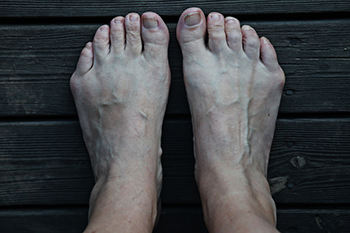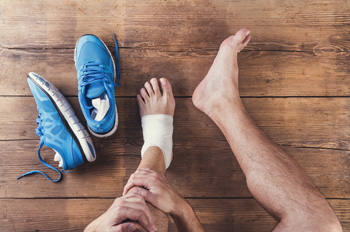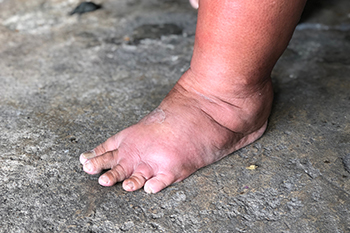A bunion is a bony bump that develops on the outside of the big toe, at the base of the big toe joint. Over time, a bunion can cause the big toe to move out of its proper alignment and lean towards the second toe. The bunion may become painful, stiff, red, and swollen. Calluses sometimes form on top of the bunion as the bunion rubs against the inside of your shoe as you walk. Calluses can also form on the area where your big toe rubs against your second toe, or on the ball of the foot.
Bunions are extremely common, especially in older adults and women, although children can develop bunions or, in very rare cases, be born with them. What exactly causes bunions is unclear. They may occur as a result of a genetic predisposition due to the shape and structure of the foot or because of one’s gait. Wearing shoes that are too tight, have excessively high heels, or narrow, pointed toes may contribute to the development of bunions. Certain medical conditions, such as arthritis and flat feet, may make bunions more likely as well.
Bunions can be treated through conservative methods such as switching the shoes that you wear for shoes that are wider and more comfortable, wearing custom orthotics, wearing pads placed over the bunion to reduce pain, taking nonsteroidal anti-inflammatory medications, and icing the foot. When conservative treatments are not effective, invasive procedures may be recommended. For more information about bunions, please consult with a chiropodist.

The side of the pinky toe can be an area where a bunion develops. It is referred to as a bunionette, or tailor’s bunion, and may happen from wearing shoes that are too tight. This can cause a misalignment in the metatarsal bone, and the toe ligaments may gradually weaken. The pinky toe may become deformed, as the toe squeezes into the shoes. Additionally, having tight calf muscles may lead to developing a tailor’s bunion, which can be a result of extra pressure that is exerted on the outside of the foot. Mild relief may be found when a protective pad is worn over the bunion, and it can help to wear shoes that have large toe areas. Having surgery performed to permanently remove the bunion may be an option if the pain becomes unbearable. If you have developed a bunionette, it is suggested that you schedule an appointment with a chiropodist who can properly treat this condition.
Bunions progressively worsen over time and may cause walking in your shoes to become difficult. To learn more about bunions, please consult with one of the chiropodists from The Footcare Centre. Our chiropodists will assess your condition and provide you with quality foot and ankle treatment.
What Are Bunions?
A bunion is a bony bump that protrudes from the base of the big toe. Bunions are caused due to a misalignment of the first metatarsal. The characteristic bump of a bunion forms when the metatarsal shifts outwards from its proper position. Bunions develop slowly over time and progressively worsen without treatment. The skin over the bunion may develop calluses due to the friction from shoes. Eventually, a bunion can make walking uncomfortable or even painful. Bunions are one of the most common foot deformities and are especially common in women and older adults.
Symptoms
A bunion appears as a bulging bump on the outside of the base of the big toe.
The bunion may also:
Be swollen, red, or sore
Develop corns or calluses over it
Cause pain
Limit the big toe’s range of motion
Treatment
There are several different treatments available for bunions. Conservative treatment options include wearing shoes with a wider toe box, cushioning the bunion with a specialized pad, wearing shoe inserts, icing the bunion if it becomes inflamed, and taking medications to relieve pain. In more severe cases, more invasive procedures may be done. This may involve removing the swollen tissue around the bunion, straightening the big toe, realigning the bones at the front of the foot, or a combination of these procedures.
If you have any questions, please feel free to contact our office located in . We offer the newest diagnostic and treatment technologies for all your foot care needs
The tarsal tunnel is a narrow space on the inside of the ankle, located next to the ankle bones. Within the tarsal tunnel are a variety of tendons, arteries, veins, and nerves, including the posterior tibial nerve. Tarsal tunnel syndrome is a condition that occurs when the posterior tibial nerve is squeezed or compressed. This can happen due to injuries that produce inflammation or swelling near the nerve, systemic diseases like arthritis, an abnormal structure such as a cyst putting pressure on the nerve, or flat feet straining the nerve as you walk.
Symptoms of tarsal tunnel syndrome include tingling, burning, or electrical shock sensations in the inside of the ankle or bottom of the foot, as well as numbness and shooting pains. In some cases, the symptoms are isolated to one small area, like the inner ankle. In other cases, the symptoms may affect the entire foot and ankle. Symptoms typically occur during or are aggravated by physical activities like walking, running, jumping, or prolonged standing.
Tarsal tunnel syndrome can be diagnosed by a chiropodist through physical examination of the affected foot and ankle. Imaging studies may be used if the chiropodist suspects that the underlying cause may be a structural abnormality, like a cyst. Treatment options for this condition include resting and icing the affected area, taking oral medications to reduce pain, immobilizing or bracing the affected foot, wearing supportive shoes or orthotic inserts, and physical therapy. Left untreated, tarsal tunnel syndrome can lead to permanent nerve damage.
If you are experiencing the symptoms of tarsal tunnel syndrome, please consult with a chiropodist.

The tibial nerve is found within the tarsal tunnel that is located in the back of the ankle. An injury can cause this nerve to become compressed or irritated, which may lead to tarsal tunnel syndrome. This is a narrow area, and may become swollen if a sprained ankle has occurred. Additionally, there may be an existing bone spur or varicose veins that can cause this condition. Patients who have medical conditions such as flat feet, high arches, diabetes, or a thyroid disorder may be prone to having this ailment. Common symptoms include foot and toe pain, and overall weakness in the foot. Tarsal tunnel syndrome is generally confirmed by having an examination performed. The inability to move the toes may lead to a positive diagnosis, which may be followed by having a nerve biopsy done. Treatment may include performing specific stretches, in addition to elevating the foot as often as possible. If you have pain in this part of your foot, it is suggested that you confer with a chiropodist who can guide you toward additional treatment methods.
Tarsal tunnel syndrome can cause pain and progress over time. If you are experiencing any symptoms of tarsal tunnel syndrome, please consult with one of the chiropodists from The Footcare Centre. Our chiropodists will assess your condition and provide you with quality foot and ankle treatment.
What Is Tarsal Tunnel Syndrome?
Tarsal tunnel syndrome is a condition in which the posterior tibial nerve, which is located within a structure called the tarsal tunnel on the inside of the ankle, is squeezed. Compression of the posterior tibial nerve can be caused by injuries, such as ankle sprains, systemic diseases like diabetes or arthritis, strain on the tarsal tunnel due to flat feet, or an enlarged structure like a cyst squeezing the nerve.
Symptoms
Symptoms of tarsal tunnel syndrome can appear suddenly and are generally worsened by physical activity.
Common symptoms include:
Tingling, burning, or electrical shock sensation on the inside of the ankle or bottom of the foot
Numbness
Shooting pain
Diagnosis
Tarsal tunnel syndrome is diagnosed through physical examination. If initial treatment is ineffective, imaging or nerve studies may also be necessary.
Treatment
Nonsurgical treatments for tarsal tunnel syndrome include resting and icing the foot, bracing or immobilizing the foot, wearing an orthotic device, modifying your footwear, and taking medications to relieve pain. Surgery may be needed if nonsurgical treatments are ineffective.
If you have any questions, please feel free to contact our office located in . We offer the newest diagnostic and treatment technologies for all your foot care needs.
Summer can be a time when the feet are particularly vulnerable to various medical problems. This is because the warm weather means that many people will wear shoes that do not adequately cushion and protect the feet or will go barefoot entirely. Fortunately, most summertime foot problems can be treated or prevented.
In the summertime, most people frequent warm, moist public areas, such as swimming pools, locker rooms, and showers, walking around barefoot. These places are breeding grounds for various fungi and viruses that can get into the feet, causing an infection. Tinea pedis, or athlete’s foot, is a fungal infection of the skin on the feet. It’s characterized by a red, scaly, itchy rash and skin peeling, usually found between the toes. Fungus can also infect the toenails, making them brittle, crumbly, thickened, and discolored. Human papillomavirus (HPV) is a common viral infection that can cause benign, fleshy growths called warts to grow on the soles of the feet. When going to public places, it’s suggested that you wear shoes to protect your feet from infectious agents and that you avoid sharing personal items like shoes and towels with others.
For many people, staple summer footwear includes flip-flops and open-back, open-toe sandals. Unfortunately, these shoes are usually flimsy and don’t protect the feet or provide any support or cushioning. Some also require you to scrunch up your toes while you walk to keep the shoes on your feet. This can lead to a variety of foot and ankle injuries, heel pain, arch pain, bunions, hammertoes, and dry, cracked heels. When shopping for summer shoes, look for shoes that fit properly and have adequate cushioning in the heel and arch area. They should stay on your feet while you walk without any effort and protect your feet from the elements. If you must wear flip-flops, limit wear to just a few hours every few days, or when going to specific places like the pool or beach.
For more information about common summer foot problems and how to treat and prevent them, please consult with a chiropodist.

When the weather is hot and you have been on your feet all day, you can get uncomfortable swelling in your feet and ankles. This is a common occurrence and becomes more likely as you age. Edema is the medical name for swelling in the lower extremities. It is the result of abnormal fluid buildup. In addition to heat, edema can be brought on by things like excessive salt intake or drinking alcohol. Those who are overweight or suffer from venous insufficiency, where the veins in the legs have trouble pushing blood back toward the heart, can be more prone to foot swelling. Certain medications can also contribute to edema, such as antidepressants, steroids, and hormones. Edema can have more serious causes, such as those involving underlying health conditions like a blood clot in the leg, an injury, or failure of the heart, kidneys, or liver. If you suffer from swelling of your feet and do not know the cause, or if the swelling does not improve with rest and cooling down, it is suggested that you consult with a chiropodist to help you find out the cause and how to best deal with it.
Summer is the season for many foot and ankle issues. If you’re suffering from a foot or ankle problem, please consult with one of the chiropodists from The Footcare Centre. Our chiropodists can help you maintain the health of your lower limbs and your mobility.
Common Summer Foot Problems
Athlete’s foot
Toenail fungus
Plantar warts
Foot and ankle injuries
Bunions
Hammertoes
Heel pain
Cracked heels
Sunburns
Blisters
Prevention
Wear supportive shoes and avoid flip-flops
Maintain good foot hygiene
Exfoliate and moisturize the heels
Apply sunscreen to the feet and ankles
Wear shoes in public areas like swimming pools, locker rooms, and showers
If you have any questions, please feel free to contact our office located in . We offer the newest diagnostic and treatment technologies for all your foot care needs.
Slow-healing wounds on the feet are a frequent complication of diabetes and always warrant prompt medical attention. Left untreated, these wounds can develop into diabetic foot ulcers (DFUs), greatly increasing your risk of infection, tissue death, and amputation. But how do these wounds form in the first place, and what can be done to prevent them?
Diabetics are often afflicted with two other co-occurring conditions, peripheral neuropathy and poor circulation. Peripheral neuropathy causes nerve damage and often affects the nerves of the lower limbs, leading to tingling, numbness, and a loss of sensation in the feet. A lack of sensation can leave you unable to physically feel pain if you cut, scrape, puncture, or otherwise injure your feet. This can be a serious problem, as pain is typically the first indication that something is wrong. When you don’t feel it happen, an injury on your foot can go undetected and untreated, progressively worsening until it forms a serious wound. These wounds usually heal slowly because of another complication of diabetes, poor circulation. When the blood supply to your feet is not adequate, this area of your body does not get the oxygen and nutrients that it needs to perform its usual processes, including wound healing. Poor circulation results in wounds that heal slowly or don’t heal at all.
Fortunately, there are measures that you can take to prevent diabetic foot wounds from occurring or worsening. Maintain good foot hygiene by washing and thoroughly drying your feet each day and performing a daily foot check. Using a mirror or with help from a caregiver, examine your feet each day for any abnormalities, such as sores, cuts, scrapes, bruises, blisters, discoloration, swelling, and ingrown toenails. If you notice any foot problems, it is recommended that you see a chiropodist who can treat these issues and offer you more information about managing your foot health.

A foot ulcer is any open sore on the foot whether it is shallow or deep. People who have diabetes, poor circulation, and structural foot abnormalities that cause pressure spots on the feet are more apt to develop foot ulcers. Diabetics often have peripheral neuropathy or nerve damage which interferes with the feeling of pain or discomfort in their feet. Such people can accidentally injure their feet and not be aware of it. The visually impaired may not be able to examine their feet and catch problems. Foot ulcers can be slow to heal if circulation is a problem and may become infected, which can show as an abscess with pus. Such infections can lead to gangrene and amputation if not tended to promptly. If you have a foot ulcer, it is strongly suggested that you visit a chiropodist for a proper examination and offer a correct treatment plan.
Wound care is the process of treating and preventing wounds on the feet. This is especially important if you have diabetes, as diabetic foot wounds are common and can lead to serious complications when left untreated. To learn more about proper wound care, please consult with one of the chiropodists from The Footcare Centre. Our chiropodists will assess your condition and provide you with quality foot and ankle treatment.
Why Is Wound Care Important for Diabetics?
While wound care is important for maintaining the health of your feet, it is especially important for people with diabetes. This is because diabetics often suffer from poor blood circulation, causing foot wounds to heal very slowly or not to heal at all. Diabetics also frequently suffer from neuropathy or nerve loss. This means no matter how big or little the wound, they might not feel it on their foot. If the wound becomes severely infected, amputation may be necessary. This is why it is imperative that diabetics complete daily foot checks.
Wound Care Basics
The best way to care for wounds is to prevent them in the first place. It is recommended that people with diabetes perform a daily examination of their feet to locate cuts, scrapes, sores, or wounds. Early detection allows for ample time to treat the wounds and prevent further complications. If you notice a wound at home, you can clean it using water, apply an antibiotic ointment, and cover the wound with a clean bandage. Seeing a chiropodist, who can examine your feet thoroughly and treat any existing wounds, can also help you maintain proper foot health.
If you have any questions, please feel free to contact our office located in . We offer the newest diagnostic and treatment technologies for all your foot care needs.


